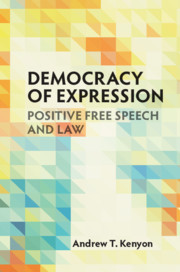Book contents
- Democracy of Expression
- Democracy of Expression
- Copyright page
- Contents
- Preface
- 1 Introduction
- 2 Positive Free Speech from Media Studies and Law
- 3 Positive Free Speech and Democracy
- 4 Positive Human Rights and Political Freedom
- 5 US Legal Writing on Positive Free Speech
- 6 German Broadcasting Freedom
- 7 French Freedom of Communication and Pluralism
- 8 Framing Communicative Freedom
- Bibliography
- Index
5 - US Legal Writing on Positive Free Speech
Published online by Cambridge University Press: 28 May 2021
- Democracy of Expression
- Democracy of Expression
- Copyright page
- Contents
- Preface
- 1 Introduction
- 2 Positive Free Speech from Media Studies and Law
- 3 Positive Free Speech and Democracy
- 4 Positive Human Rights and Political Freedom
- 5 US Legal Writing on Positive Free Speech
- 6 German Broadcasting Freedom
- 7 French Freedom of Communication and Pluralism
- 8 Framing Communicative Freedom
- Bibliography
- Index
Summary
This chapter primarily examines US legal writing on free speech that uses ideas of positive freedom. The examples show how positive dimensions of free speech can be argued for even where formal law is highly negative in approaching the freedom. The examples contain repeated calls for diverse public speech that, in some way, is promoted by government. They are aware that speech arises within existing practices of communication, practices that constrain as well as enable speech; the freedom involves dialogical, social or structural interests, not only individual ones; and government always affects opportunities for speech, not only when it directly restricts speech. While the examples link speech with democracy, many do not address any communicative preconditions to democracy, such as an architecture for speech inhering in the idea of democracy itself. However, some legal writing does address just such preconditions, providing a useful introduction to the next two chapters that consider examples of courts acting in support of positive free speech precisely because the freedom is understood to be a precondition of democracy.
Keywords
- Type
- Chapter
- Information
- Democracy of ExpressionPositive Free Speech and Law, pp. 117 - 138Publisher: Cambridge University PressPrint publication year: 2021



